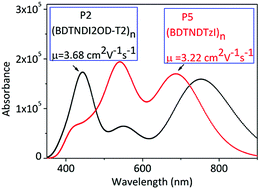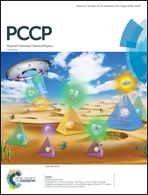Novel benzodithiophene-based polymer acceptors for efficient organic solar cells†
Abstract
All polymer organic solar cells afford unique potentials due to the tunable chemical and electronic properties of both polymer donors and polymer acceptors. Compared with the rapid development of polymer donors, the development of polymer acceptors lags far behind. To seek high-performance polymer acceptors used in organic solar cells, based on the experimentally reported D–A polymer acceptor (NDI2OD-T2)n (P1), a series of novel acceptors, designated as (BDTNDI2OD-T2)n(P2), (BDTNDTI)n(P3), (BDTNDI2OD-Tz2)n(P4), and (BDTNDTzI)n(P5), were designed by introduction of a benzodithiophene (BDT) unit and the nitrogen atom in the bridged thiophene ring. The density functional theory (DFT) and time-dependent density functional theory (TDDFT) methods were applied to study the effect of the BDT unit and the nitrogen atom on the geometrical, optical, electronic, and charge transport properties. The obtained results show that incorporation of the electron-donating BDT unit into P1 and the replacement of a carbon atom by the nitrogen atom in the bridged thiophene ring are effective strategies to lower the lowest unoccupied molecular orbital (LUMO) energy and exciton binding energy, and enhance light-absorbing capacity and electron mobility. Moreover, among the investigated molecules, P2 and P5 exhibit stronger and broader light absorption, higher light absorption efficiency and exciton separation ability as well as electron mobility; therefore they are recommended as promising polymer acceptors for future high-efficiency organic solar cells.



 Please wait while we load your content...
Please wait while we load your content...